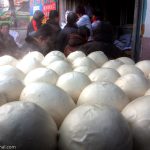Breakfast the Chinese Way (中式早饭) Posted by Stephen on Dec 21, 2011 in Uncategorized
 When one thinks of Chinese cuisine, one usually imagines a mixture of chopped meats, veggies and starches flash-cooked in oil and served alongside rice or noodles. This is traditional Han Chinese food, served all throughout the day, breakfast, lunch and dinner–reliable as the sunrise. Yet, as a foreigner living in China, what are your non-Han options, outside of the wok? Waking up hungry and finding a plate of rice is wholly unsatisfying. What about Chinese breakfast?
When one thinks of Chinese cuisine, one usually imagines a mixture of chopped meats, veggies and starches flash-cooked in oil and served alongside rice or noodles. This is traditional Han Chinese food, served all throughout the day, breakfast, lunch and dinner–reliable as the sunrise. Yet, as a foreigner living in China, what are your non-Han options, outside of the wok? Waking up hungry and finding a plate of rice is wholly unsatisfying. What about Chinese breakfast?
Over the years and as the pace of Chinese daily lives has quickened to a crescendo amidst modernization, Chinese 快餐 (kuài cān) or fast food has evolved to meet those high-paced demands, most notably in the breakfast sector.In liu of modernization, the Chinese developed a couple of awesome breakfast snacks that are cheap, convenient and delicious.
Most Chinese breakfast snacks you can get for about 3-8 块 and most are conviently found on the street sides from mobile snack carts. They also decided that chopsticks were incompatible with the “get up and go” breakfast culture of China, and as a result, most breakfast food is eaten by hand (usually out of a plastic bag).
All you have to do is walk out of your apartment, find a street cart and start waving your money around. Just remember that it’s “first come, first serve”, which doesn’t hold the same meaning in Chinese: it means the first person to muscle their way to the front of the line gets breakfast first.
Here are some examples of popular Chinese breakfast found on the street:
Mantou (馒头):
Mantou or 馒头 (mán tou), is the quintessential Chinese breakfast for someone on the go. They are typically eaten as a staple in northern parts of China where wheat, rather than rice, is grown. They are made with milled wheat flour, water and leavening agents. In size and texture, they range from 4 cm, soft and fluffy in the most elegant restaurants, to over 15 cm. They are firm and very calorically dense, making them the ideal “working man’s lunch”. There isn’t really a crust, as the exterior of the 馒头 is softer than western buns.
Traditionally, mantou has provided a staple of carbohydrates for the northern Chinese diet, where rice filled diets aren’t so prevalent. Restaurant mantou are often smaller and more delicate and can be further manipulated, for example, by deep-frying and dipping in sweetened condensed milk. Some even are split in half, oiled and heavily spiced so they can be served as 馒头串!
Jiānbǐng (煎饼)
My absolute favorite breakfast treat is jiānbǐng or 煎饼,which translates literally as “fried biscuit”. A better translation, in my opinion, is “Chinese omelet” or “Chinese crepe”. It’s a simple breakfast meal, but quite filling as it incorporates bread, egg and vegetables. Basically the “crepe” batter is poured on a circular, flat skillet and flipped over. Then egg, meat, vegetables and a dry “biscuit” (it’s actually more like rice cracker) is sandwiched on top, and then the edges of the crepe are folded over and cut in half. The result is a square-like layering of savory, spicy and crunchy. Here’s a video of 煎饼 being made by Sasha:
Ròujiámó (肉夹馍)
肉家馍 (ròujiámó) sandwiches are as close as you can get to a Chinese “Egg Mcmuffin” without shelling out lots of coin at McDonalds or 麦当劳 (mài dāng láo). Think of these sandwiches as China’s version of a hamburger or Philly-Cheesesteak, just without the cheese or red meat. It’s a mix of marinated and chopped up pork with onions and peppers, wedged between a flattened bun (包面) and often includes egg or 鸡蛋 (jī dàn). Watch 肉家馍 being prepared:
Bāozi 包子
Last, but certainly not least, is the staple of Chinese breakfast: bāo zi or stuffed steamed buns. There are countless forms of 包子 including every imaginable stuffing, be it veggie-based, meat-based or both. They are incredibly cheap, travel well, keep well and are so very, very delicious. They come in all shapes and sizes, but one thing is for certain, they will fill you up and get you to lunch. You can learn to make your very own 包子 in the video below:
http://www.youtube.com/watch?v=5P4DS0vKQG4
Are you starving yet? 你饿死了吗?
Follow Steve on twitter: @seeitbelieveit

Build vocabulary, practice pronunciation, and more with Transparent Language Online. Available anytime, anywhere, on any device.
About the Author: Stephen
Writer and blogger for all things China related. Follow me on twitter: @seeitbelieveit -- My Background: Fluent Mandarin speaker with 3+ years working, living, studying and teaching throughout the mainland. Student of Kung Fu and avid photographer and documentarian.




Comments:
Steven C. Poling Jr.:
What about 馒头 (man2tou)? ^_^
Steve:
@Steven C. Poling Jr. Of course. 馒头 is a staple of Chinese breakfast. They’re like “Chinese bagels” or sliced bread, great for someone hungry but on the go.
-S
Morris:
I love Bāozi so much,especially the meat Bāozi is just an amborsia.
Morris:
I love Bāozi so much,especially the meat Bāozi is just an ambrosia.
Steve:
@Morris It’s amazing baozi isn’t popular in the United States and around the globe. It is one of the most perfect foods.
-S
Eddie Chung Gon:
Xie Xie !
Hao Chi !